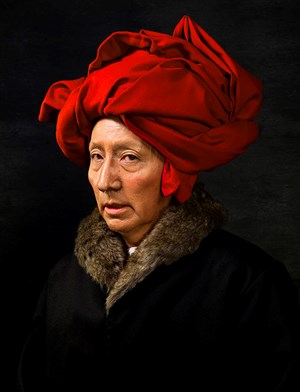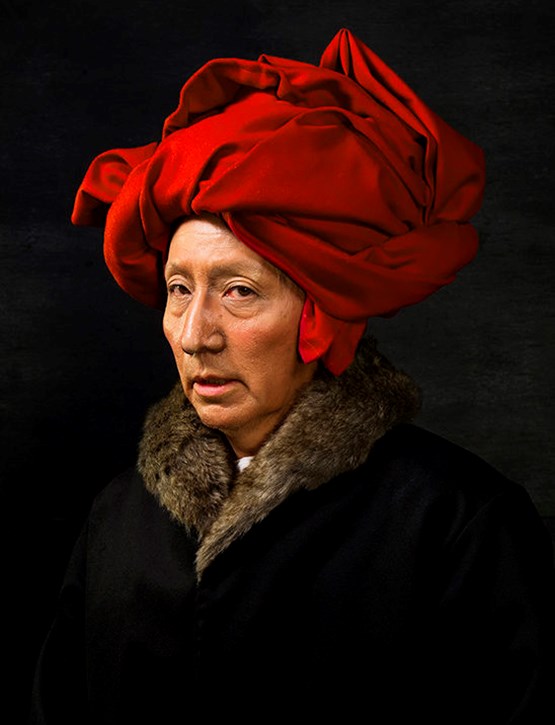
Given the centrality that the development of China and Chinese cultural production has in defining the complexity of our current world, the Shanghai Biennale appears as an ideal place to show both the role of contemporary art as a critical sensibility of the dialectic of emancipation and power. The Shanghai Biennale will present contemporary artworks that embody an epoch that defies any idealized narrative.
Image: Yasumasa Morimura, Van Eyck in a Red Turban, 2016, Color photograph, 57 x 44 inches, (145 x 111 cm)
Theme of the 12th Shanghai Biennale: Proregress —Art in an Age of Historical Ambivalence.
pity this busy monster, manunkind,
not. Progress is a comfortable disease:
your victim (death and life safely beyond)
plays with the bigness of his littleness
E. E. Cummings
"Among the many language discoveries that emerged from E. E. Cummings’ experiment in poetry, is a word made of the condensation of progress and regress: Proregress[1]. Introduced in the XIXth section of W ViVa (1931), this term may illuminate much about the contemporary conditions of history and time.
As the late Zygmunt Bauman argued, today‘s culture appears as a “negation of negation of utopia”, or what he called “Retropia[2].” Our historical horizon is defined by nostalgia and a constant assessment of our relationship with the past. However, the question of our relationship with progress and regression is not solely related to the way we negotiate our hopes or fears in the line that goes from the future to the past. It also involves the intensification of the experience of historical change in our societies, which is related in turn to the mixture of advancement and regression of all kinds of social agendas.
In fact, we have grown used to experiencing historical time as a constant swing between moments of transformation and stagnation,which firmly contradict both optimists and pessimists alike. Different from what the secular theologies of modernity assumed, we experience the present as a combination of contradictory trends and forces, which can be reduced easily neither to any simple narrative of development, nor to the prophecies of decadence or gloom. We find emancipation and empowerment overtaken by despair, as we witness the return of old forms of discrimination and obscurantism. There is no chapter of social transformation that has not raised an antagonistic formation. The advancement of feminism battles new forms of misogyny and gender violence. The geographical relocation of the industrial economy to the east and south has given rise to right-wing movements, xenophobia, and virulent forms of religious and cultural fundamentalism. The experimentation with bodies and family structures is met by all kinds of cultural wars. The promise of technoscience in shaping our civilization has become inseparable from the dangers posed by climate change in the anthropocene, which now threaten us with the end of times.
 Yasumasa Morimura, Van Eyck in a Red Turban, 2016, Color photograph, 57 x 44 inches, (145 x 111 cm)
Yasumasa Morimura, Van Eyck in a Red Turban, 2016, Color photograph, 57 x 44 inches, (145 x 111 cm)
Artworks as witnesses of the ambivalence of the present
The constant combination of gain and loss, openness and fear, acceleration and reaction, which defines our era of “proregression”, also exists as a sensibility characterized by profound ambivalence. In this context, contemporary culture appears as a complex site of reflection defined by excess and powerlessness, transgression and repression, social activism and many brands of nihilism. Contemporary art appears as a production of singularity and refinement made of fragments of the social debris, encapsulating conflicting forces. “Proregress” provides a framework to explore the role of contemporary art as a means by which the struggles and anxieties of many different latitudes are reflected and turned into subjective experience, training the contemporary subject in the ambivalence the allows us to tolerate the contradictory forces of contemporary life.
Given the centrality that the development of China and Chinese cultural production has in defining the complexity of our current world, the Shanghai Biennale appears as an ideal place to show both the role of contemporary art as a critical sensibility of the dialectic of emancipation and power. “Proregress” hopes to capture excitement akin to the exhilaration that the discovery of the plasticity of language provoked avant-garde poets like Cummings. In that sense, I propose a biennale that explores art in the present as a poetic attempt to explore the combination of progress and regression in the global arena. It will collect practices and artworks that advance our sensibility to absorb the current instability of the economy, culture, and politics. The Shanghai Biennale will present contemporary artworks that embody an epoch that defies any idealized narrative.
For the Chinese title of the Biennale, we have chosen the concept of 禹步(YUBU), the basic mystic dance step of Daoist ritual in ancient China. This dancing technique makes the dancer look like he or she is moving forward while going backwards at the same time. Beyond translating a concept made of western binary concepts into Chinese, this figure also suggests the importance of the pursuit of a way of thinking and culture that ought to help us thrive despite the ambivalence of our era".
The 12th Shanghai Biennale
November 10, 2018 - March 10, 2019

ArtDependence Magazine is an international magazine covering all spheres of contemporary art, as well as modern and classical art.
ArtDependence features the latest art news, highlighting interviews with today’s most influential artists, galleries, curators, collectors, fair directors and individuals at the axis of the arts.
The magazine also covers series of articles and reviews on critical art events, new publications and other foremost happenings in the art world.
If you would like to submit events or editorial content to ArtDependence Magazine, please feel free to reach the magazine via the contact page.